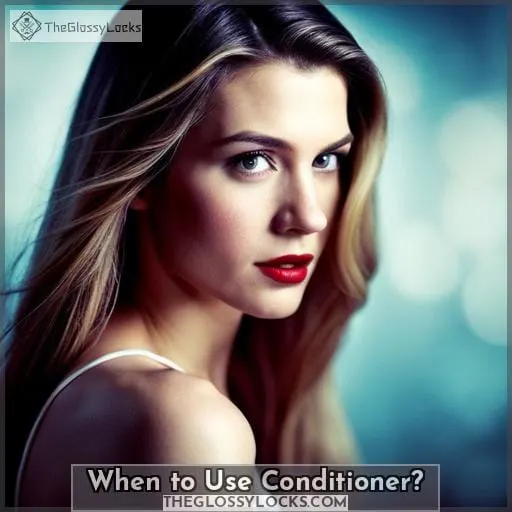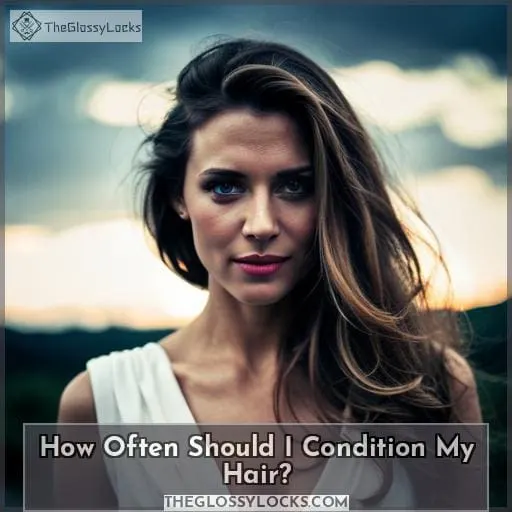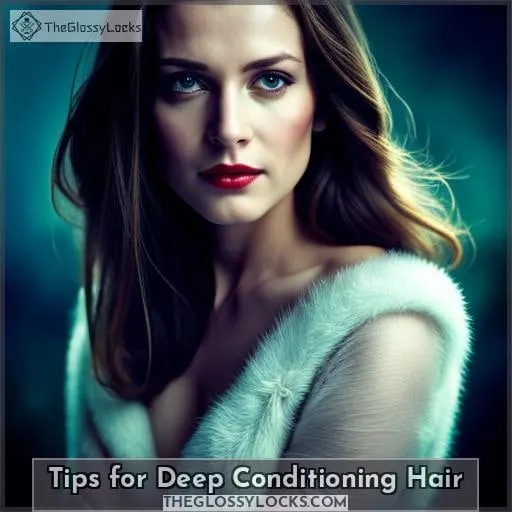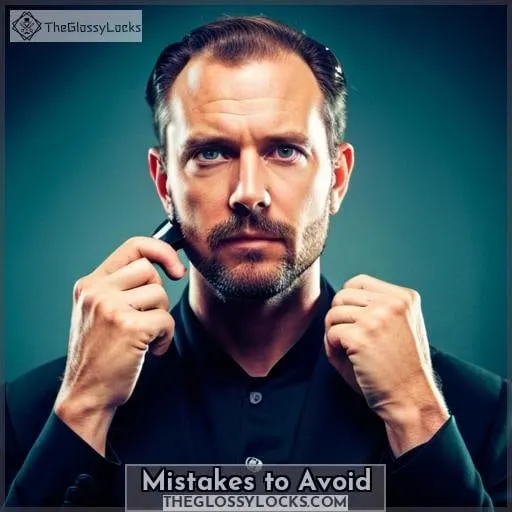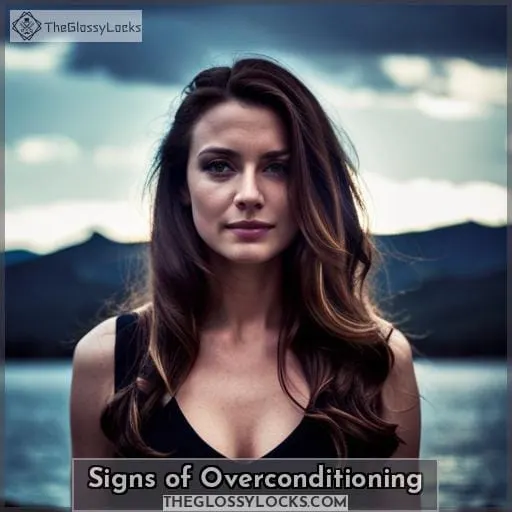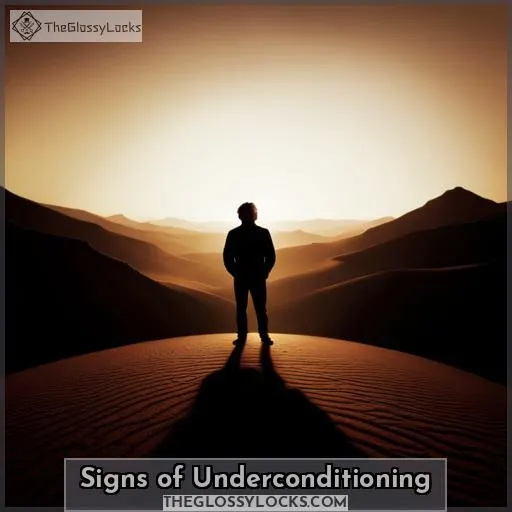This site is supported by our readers. We may earn a commission, at no cost to you, if you purchase through links.
Are you wondering how often you should condition your hair? The answer depends on several factors, including the type of hair you have and the products that are best for it. Whether it’s a rinse-out conditioner, leave-in, or deep conditioning treatment, knowing when to use them is essential in achieving beautiful locks without over-conditioning.
To help guide your hair care routine and keep it healthy and manageable, here are some tips on when to apply conditioner and what mistakes to avoid.
Table Of Contents
Key Takeaways

- Conditioner frequency should be determined by hair type and texture.
- Rinse-out conditioner is recommended after every wash for dry, coarse, or color-treated hair, just like with nourishing beard conditioners
.
- Leave-in conditioner should be applied once a week for mildly to moderately dry hair.
- Deep conditioning treatments should be done once a month or every two months for severely damaged hair.
When to Use Conditioner?
You should tailor your conditioning routine to suit the needs of your specific hair type and texture. Silicones can provide a protective coating for very dry or curly hair, while oils and emollients help maintain softness and hydration for all types.
Rinse-out conditioner is recommended after every wash for those with dry, coarse, or color-treated locks. Leave-in conditioner should be applied once a week to mildly to moderately dry strands. Deep conditioning treatments are best suited once every month or two for severely damaged tresses.
Coarse curls may benefit from co-washing with conditioners instead of shampooing alone in order to create balance between moisture levels without stripping away natural oils. Finding the right balance of shine, buoyancy, and smoothness requires experimenting with different types of products tailored towards individual haircare needs in order to achieve desired results efficiently while avoiding overconditioning signs such as greasiness, as well as underconditioned signs like brittleness from lack of sufficient moisturizing agents necessary on certain textures.
How Often Should I Condition My Hair?
Getting the perfect hair can be a challenge, but with proper conditioning, it is possible. Depending on your specific hair type and texture, you should tailor your conditioning routine to best suit your needs.
Rinse-out conditioner should be applied after every wash for those with dry or coarse strands. Leave-in conditioner is recommended once a week for mildly to moderately dry locks. Deep treatments are suggested monthly or bi-monthly for severely damaged tresses.
Cleansing conditioners provide an alternative way of washing curly hair without stripping away natural oils.
Rinse-out Conditioner
Rinse-out conditioner should be used after each wash to maintain softness and shine, replenishing moisture lost from shampooing. The frequency depends on your unique hair type. Silicones provide a protective coating for dry or curly locks, while oils help keep all types hydrated.
Co-washing is beneficial for coarse curls. Deep conditioning repairs damaged strands, and cleansing conditioners are ideal for fine or oily tresses. Experiment with products tailored to individual needs to avoid signs of overconditioning, such as greasiness, as well as signs of underconditioning, like brittleness caused by a lack of necessary moisturizing agents on certain textures.
Leave-in Conditioner
Leave-in conditioner is a great way to keep your locks looking their best. Adding shine and softness without weighing them down, it hydrates all hair types while allowing for heat styling. Product buildup can be prevented with occasional co-washing or an apple cider vinegar rinse.
Leave-in products also contain cationic surfactants and emollients, which help replenish hydration levels without over-conditioning.
Deep Conditioner
Slather on some deep conditioner for a luxurious spa-like experience that will replenish your locks with moisture and help repair any damage.
Deep conditioning treatments should be applied every couple of weeks to optimize the hydrating benefits, allowing you to go through the restoration process quickly without overdoing it.
Co-washing techniques can also be used in between deep conditioning sessions, as well as when you’re looking to heat style your hair or switch product selection.
For additional guidance on how often and why one should use deep conditioner, consult an American Academy of Dermatology dermatologist or celebrity hairstylist—you’ll soon have longer locks than ever before!
Too much product? No worries—simply rinse out more frequently until balance is restored!
Cleansing Conditioner
Try a cleansing conditioner for a gentle cleanse that won’t strip away essential moisture. It’s ideal for caring for curls, has silicones to add shine, and is perfect when you want to choose different types of conditioners.
Co-washing benefits include longer periods between washes and great hydration without overloading the hair with product. Deep conditioning tips suggest applying one every month or two – a good choice if your hair type needs extra help! Rinse-out conditioner should be used more frequently depending on the main uses of it; oily/fine hair less often while dry/coarse hair can withstand longer periods between applications.
Tips for Deep Conditioning Hair
It’s time to take your conditioning routine to the next level with deep conditioning. Deep treatments are aptly named, as they penetrate deeper into hair strands than other types of conditioner, providing maximum moisture replenishment and repair for very damaged tresses.
Follow these tips from celebrity hairstylist Michelle Cleveland-Hill for best results:
- Start by shampooing and rinsing well before applying a generous amount of deep conditioner throughout the hair shafts.
- Cover with a plastic cap or warm towel and leave on for 30 minutes or more depending on how severely damaged your locks are.
- Rinse thoroughly until all product is removed then style as desired while still damp using heat styling tools if necessary – just make sure not to use too much heat!
- Repeat this process every couple weeks based on your individual hair type (coarse/curly vs fine/oily).
Mistakes to Avoid
Avoid over-conditioning your tresses, as too much moisture can leave them greasy and flat. To prevent this mistake, hairstylist Ryan Trygstad recommends being aware of the type and frequency of conditioner you use.
If you have very oily or fine hair, try using a light rinse-out conditioner every few washes instead of deep conditioning monthly. For curly or color-treated hair that needs more hydration, apply a moisturizing leave-in once per week in addition to rinsing out after each wash for optimal results.
Cleansing conditioners are also an option; they cleanse without stripping away essential oils and can be used daily for finer strands or less frequently for thicker types.
Lastly, avoid any shampoo altogether when co-washing with conditioner as this technique requires only water & product applied liberally throughout the scalp area while avoiding roots entirely – allowing curls/waves/kinks to remain bouncy & full-bodied all at once!
Good thing there’s expert advice from professionals like Ryan Trygstad who know exactly how often (and what amount) we should be using different types of products on our manes depending on their unique texture needs – something everyone should take advantage of if they want healthy-looking locks year-round!
Signs of Overconditioning
You may notice signs of overconditioning if your hair starts to look greasy and flat, or if you find it difficult to style with heat. Interestingly, hairstylist Ryan Trygstad recommends that the average person should only use conditioner 2-3 times per week.
Signs of excessive conditioning include:
- Lack of volume and difficulty styling with heat due to weighed-down strands
- Greasiness on the scalp due to an accumulation of product buildup
- Excessive shine as a result of too much silicone in conditioners
Coarse hair types may require less frequent conditioning treatments than those with thinner textures. However, determining which type is best for your locks depends on their individual needs.
Signs of Underconditioning
If your hair is suffering from underconditioning, you may notice signs such as dryness, brittleness, tangling, frizz, and dullness. To help remedy this situation and restore balance to your strands, it’s important to evaluate the type of conditioner used as well as how often it is applied.
Depending on the thickness or texture of your hair, some types require more frequent conditioning than others. For instance, fine or oily locks need less, while curly or color-treated tresses can benefit from an extra boost now and then.
Moisturizing remedies like a deep treatment should be included in any haircare routine every month at least.
Avoid taking a yo-yo approach when trying to tackle underconditioned manes. Start off slow until you find what works best for yours before increasing frequency based on individual needs!
Frequently Asked Questions (FAQs)
What type of conditioner should I use?
Find a conditioner tailored to your hair type and use it regularly for noticeable results. Choose an intensely moisturizing deep conditioner for dry, brittle hair or opt for lightweight leave-in formulas if you have fine strands.
For all types, try cleansing conditioners that cleanse without stripping away natural oils.
What is the difference between rinse-out, leave-in, and deep conditioners?
Rinsing out conditioner is similar to washing away dirt; it removes buildup and refreshes hair. Leave-in conditioners coat the strands, providing a shield of protection from heat and styling damage. Deep conditioning is like diving deep into the ocean for a restorative soak; it repairs damaged locks with intense moisture.
How do I co-wash with conditioner?
Co-washing with conditioner is a great way to cleanse and condition your hair at the same time. It’s gentler than shampooing, so it’s perfect for curly hair that needs extra hydration. To co-wash, start by wetting your hair thoroughly, then apply generous amounts of conditioner throughout it.
Can I condition my hair too often?
Conditioning your hair too frequently can result in overconditioning, which is evident through greasiness, lack of volume, and excessive shine. For instance, if you use a deep conditioner every week, consider applying it monthly instead to achieve optimal results.
It is important to understand the appropriate balance of moisture and styling requirements for your specific hair type in order to maintain its healthy appearance.
Are there any benefits to applying conditioner to the roots of my hair?
Applying conditioner to your roots can help nourish and hydrate the scalp while also providing some protection from environmental damage. It will give you softer, shinier hair with improved manageability without overloading it with product.
Conclusion
It’s important to find the right balance when conditioning your hair. Too much or too little will lead to damage and hair that’s difficult to manage.
On average, people should condition their hair at least once a week, with more frequent conditioning for dry, coarse, or color-treated hair. Deep conditioning should be done once a month, or every other month, to repair and hydrate very dry or damaged hair.
A survey of 5,000 people revealed that only 23% of those surveyed deep condition their hair once a month.

